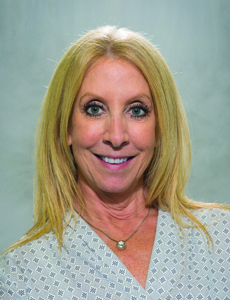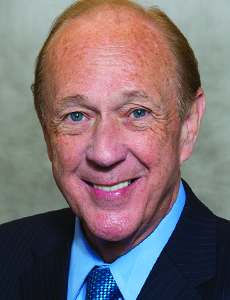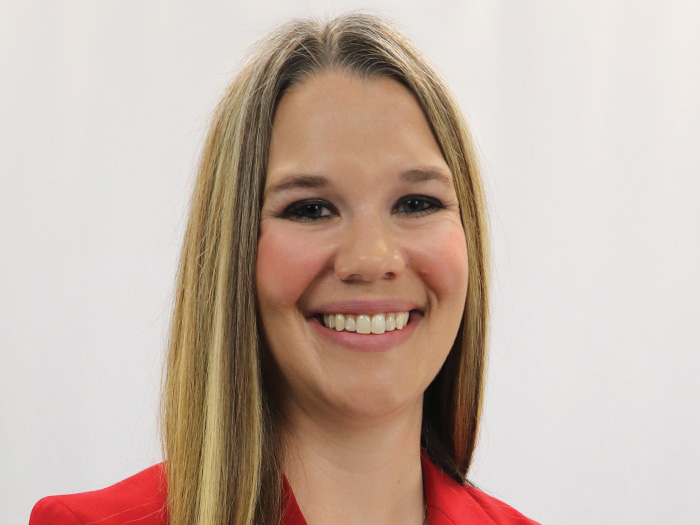2015 Teddy Award Winner
Spreading Success
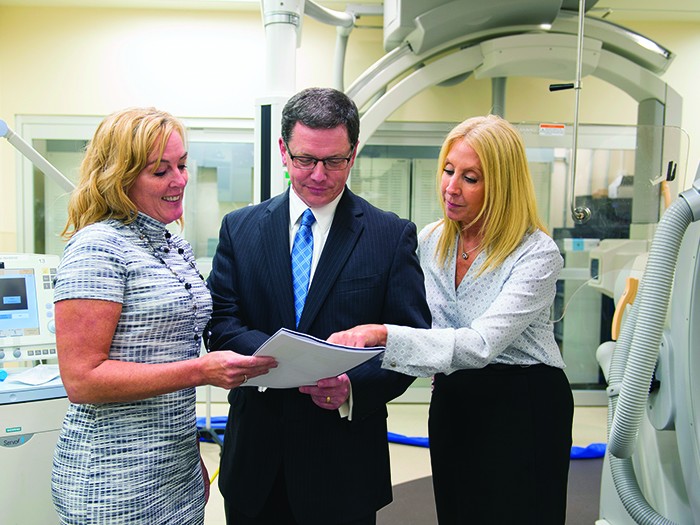
From left, Caroline Burhenne, PMA Cos. account manager for Barnabas Health; Keith Lavin, manager, corporate care; and Caryl Russo, senior vice president, corporate care.
This success story started in one department in one hospital. Workers’ compensation transformed into something called Corporate Care. Let the data display the success.
At first, Kimball Medical Center, now known as Monmouth Medical Center, Southern Campus, in Lakewood, N.J., experienced 51 cases of injured workers with days out of work, for 1,156 total lost days and estimated expenses of $1.16 million. That was in 2007.
By the following year, those numbers dropped to 35 cases, 353 total days out of work and $353,000 in expenses. By 2011, it was six cases, 129 total days and $129,000 in expenses.
What happened next was spreading that one success story to the rest of the
Garden State’s largest nonprofit health care system, Barnabas Health, with its 5,200 physicians, 21,000 employees and more than two million annual patient visits.
The initiative began when Caryl Russo, now senior vice president for Corporate
Care, and her team wanted to expand their efforts, in both scope and geography. Russo brought the data from Monmouth South to the attention of Barnabas Health’s senior management, along with several actual workers’ comp cases to humanize the issue.
Russo and her team wanted to transform what was already a good workers’ comp program overall across Barnabas Health into something exceptional.
Barnabas is being honored as a 2015 Teddy Award winner because they succeeded.
The Transformation Begins
The Monmouth South team realized that the traditional way workers’ comp occurred in the hospitals — operating out of the employee health department and utilizing a nurse or advanced practice nurse — was not optimal, said Joe Hicks, then CEO of Kimball and now president and CEO of Barnabas Health Behavioral Health Network and Corporate Care.
The first change at Monmouth South played to its strength: providing health care.
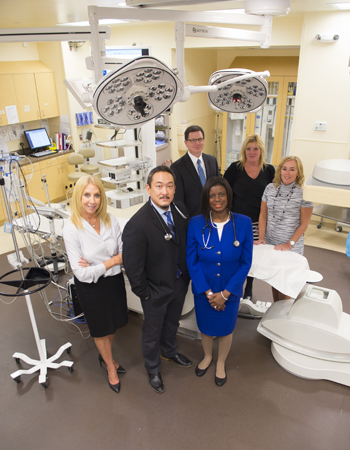
Back Row: Keith Lavin, manager; Elaine Blandino, director, Caroline (Cari) Burhenne PMA account manager for Barnabas Health.
Front Row: Caryl Russo, senior vice president, Dr. Richard Yoon, medical director, Dr, Tanisha Taylor, senior medical director.
The small corporate care department led by Russo and manager Keith Lavin brought in a board-certified occupational medicine physician, Dr. Tanisha Taylor, and partnered her with a workers’ comp specialist.
The pair became “gatekeepers” who managed all injuries, notified supervisors of accident investigations, assessed underlying causes and even worked toward their remediation.
A primary benefit of gatekeepers is that they help reverse the trend whereby 60 cents of every workers’ comp dollar goes to medical costs.
Occupational physicians can help manage referrals and work with specialists. They can also keep the lid on prescription abuse, important in a world where one in three people addicted to prescription meds begin their abuse after a work injury.
The team’s efforts made this one small department at this one hospital stand out. Which is impressive because although processes and efficacy of workers’ comp efforts across the Barnabas Health system were uneven, its overall program was fairly successful.
“When we started this process, Barnabas Health had a pretty impressive MOD rating,” Russo said. “A lot of companies would have been satisfied and left it at that.”
Yet the corporate care team pushed forward. As Hicks recalled, their next step was to spread the revolution.
It would require the mind-set of a “product line,” and a management team to take administrative charge, control elements of the “product” and promote it across the entire system — which includes six other acute-care hospitals, two children’s hospitals, a behavioral health center, ambulatory care facilities, geriatric centers, women’s health centers, and home care and hospice services.
“We took it step by step and integrated the program into one facility at a time,” Hicks said.
They started with buy-in from corporate senior leadership by wielding the results from their successful experiment at Monmouth South — for lost time claims, direct incurred costs and disability days.
Next, they moved to the executives at the individual facilities, translating these metrics into financial implications for each and the “extreme costs” of not making a change.
Most of the Barnabas CEOs assumed workers’ comp was just a cost of doing business. The team brought the data to life with real-life workers’ comp anecdotes.
“Showing cause and effect with real-life stories about actual people was very successful,” Russo said, adding that the ultimate message was: “One injury, especially one that could be avoidable, is unacceptable.”
Standardized Success
Given the green light, the team began to spread the corporate care way of doing things. But it was not just about hiring highly qualified occupational medicine physicians to serve as gatekeepers at each location.
The program’s framework afforded them the opportunity to standardize and improve all of the elements of the workers’ comp system, from injury management and accident investigations to policies governing employee safety.
One such innovation is a weekly conference call on all open claims.
A team, including the adjusters; the account manager for the company’s TPA, PMA Cos.; the facility’s occupational medicine physician; the workers’ compensation specialist; and Russo, examine care plans for injured employees, looking at any delays in treatment, discussing those who are able to return to work and plotting strategy.
They tackle the latest issues and injuries to identify emerging trends and discuss investigative results with an eye toward remediation.
“Every week when we go over these cases, we discover ways in which we can make our employees’ work environment safer … and we jump on them right away,” Russo said.
Targeting Safety Issues
Remediation efforts come via a number of avenues.
One is the health system’s safety team, led by Rajvinder Kaur, assistant vice president of safety management. Barnabas Health brought in Kaur nearly three years ago.
At that time, she evaluated how Barnabas Health facilities collected data after incidents and their average response times. Kaur and her team have since partnered with corporate care, and they get called in immediately after a work-related incident occurs.
This partnership and the data Kaur gathers help spotlight emerging safety issues, like the need for patient lifting equipment or for a wire management safety program.
“Safety now is critical,” Russo said.
The program also focuses on measurement. Barnabas worked with PMA Cos. from the start to gain real-time data from the TPA on those pivotal metrics of total claims, disability days, lost-time claims and incurred dollars — on at least a monthly basis for every site.
“We took it step by step and integrated the program into one facility at a time.” — Joe Hicks, president and CEO, Barnabas Health Behavioral Health Network and Corporate Care
For return-to-work, Barnabas Health launched another systemwide effort: a modified job bank. Each facility now operates a bank, which provides different accommodations across various skills, shifts and even languages. Each case is personalized and handled at the local facility level, but the twist is that now the human resources department pays for the position. This ensures departments are willing to bring on the injured employees.
“Subsidizing these positions benefits everyone and ensures a smooth transition back to work for our employees,” Russo said.
One of rarest innovations that began at Monmouth South involved how the corporate care team partners with the various Barnabas Health emergency departments to provide care for workers injured on second and third shifts.
The effort underscores the team’s ability to spread their gospel and involved getting the medical directors at each of the ERs to:
- Refer all workplace injuries (except the most serious) to corporate care the next morning;
- Recognize that most musculoskeletal injuries do not warrant narcotics; and
- Understand that work dispositions are the domain of the occupational physician.
The efforts are going so well that other businesses in the region know to send work-related injuries to Barnabas Health ER departments, Russo said.
The sum total of these innovations can be seen in corporate care’s workers’ comp numbers. In 2011, before the efforts to spread the new model, total incurred costs per claim were $3,312.
By 2014, Barnabas Health had that number down to $1,147, while reducing the total frequency rate by 54 percent. Its indemnity to medical-only ratio was 1:8.33 in 2011 vs. 1:17.88 in 2014, while average number of lost days per claim went from 38 to 24, respectively.
Approximately 94 percent of medical-only claims since 2012 have a total incurred cost per claim of less than $1,000, and more than 60 percent of the lost time claims have a total incurred amount of less than $25,000.
For the organization, the program has yielded a three-year savings of more than $3.5 million and a significant reduction in reserves. This, while the total number of employees increased from 18,198 to 21,028.
For the Barnabas Health workers’ comp team, though, the real success comes in seeing employees able to live better because they’re healthy and safe on the job.
_______________________________________________________
Read more about all of the 2015 Teddy Award winners:
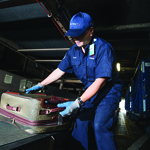 Revamped Program Takes Flight: The American Airlines and U.S. Airways merger meant integrating workers’ compensation programs for a massive workforce. The results are stellar.
Revamped Program Takes Flight: The American Airlines and U.S. Airways merger meant integrating workers’ compensation programs for a massive workforce. The results are stellar.
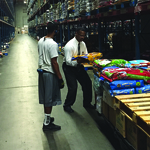 Checking Out Solutions: From celebrating safety success to aggressively rooting out fraud and abuse, Stater Bros. Markets is making workers’ comp risk management gains on multiple fronts.
Checking Out Solutions: From celebrating safety success to aggressively rooting out fraud and abuse, Stater Bros. Markets is making workers’ comp risk management gains on multiple fronts.
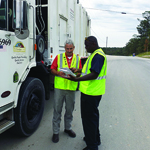 Revitalizing the Program: In three years, the Columbus Consolidated Government was able to substantially reduce workers’ compensation claims costs, revamp return-to-work and enhance safety training.
Revitalizing the Program: In three years, the Columbus Consolidated Government was able to substantially reduce workers’ compensation claims costs, revamp return-to-work and enhance safety training.
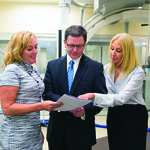 Spreading Success: Barnabas Health wins a Teddy Award for pushing one hospital’s success in workers’ comp systemwide.
Spreading Success: Barnabas Health wins a Teddy Award for pushing one hospital’s success in workers’ comp systemwide.

